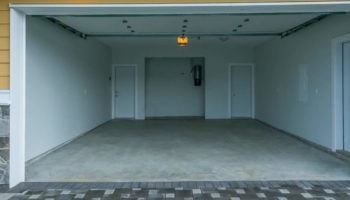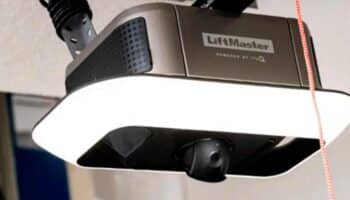You pull up to your driveway after a long day at work, just wanting to get home and relax.
But find yourself uselessly stabbing the button on your garage door remote.
You creep closer, getting angrier as you’re stuck outside your garage that’s obstinately refusing to open… but nothing works until you’re almost nose to door.

Irritated, you head indoors, wondering why you paid all that money. After all, what use is a remote control that has a range of two feet?
Often, a garage door remote can start off with a huge range. Dozens, if not hundreds of feet. Over time though, the range tends to creep lower and lower.
It’s a common problem that can be easily solved. If you know what you’re doing.
Increasing The Range of a Garage Door Opener
In short, some of the best ways to increase the range of a garage door opener are to make sure there’s no electrical interference, ensure the remote works well and has fresh batteries, check the frequency, and set up an antenna booster.
That’s the short answer anyway, but there’s plenty more detail to be covered…
–which is why we’ve written this guide, so keep reading to find out how to increase the range of your garage door opener.
What is the standard range of a garage door opener?
Most garage door remotes are designed to work with a maximum range of around 3 to 5 car lengths, or around 50 feet.
This gives a remote enough range that it will work when you pull into your driveway, but not enough to cause issues.
It’s a safety feature, helping to prevent injuries and stopping people from getting into and out of your garage by preventing you from accidentally activating your garage door remote before you pull into your drive or as you leave in the morning when it’s out of your line of sight.
All garage door openers are confined by FCC regulations in the USA and European safety standards which limit the range, usable frequencies, and total power of the unit.
Why could your garage door opener be losing range?
There are a few obvious reasons why your garage door opener could be losing range, but the two most common are electrical interference and dead batteries.
Electrical interference
The list of things that can cause interference with a remote, (like your garage door remote) is absolutely huge. It’s probably easier to say that anything that uses electricity can cause an issue.
- Almost all electrical products can create interference
- TV and phone cabling
- Amps, generators, and battery chargers
- LED or fluorescent lighting
- Freezers
- Anything that has a timer, including sprinklers, intruder alarms, and lights
- Living next to a business that might have security systems
- Anything that broadcasts a lot of radio, like airports, prisons, phone and radio towers
If your garage is close to a neighbour’s home, they might also be interfering with your signal. It’s worth checking whether they have an automatic garage door, as they could be interfering with each other.
If not, then anything on our list that’s close enough to your property could also cause a problem.
The garage door light bulb
It sounds ridiculous to point out, but even a simple light bulb could be causing issues in your signal, especially if you’ve recently changed it. Certain types of LED or fluorescent bulbs can cause interference as part of their normal operation. The interference is caused by the driver in the bulb producing a signal that can block the remote, and in the worst cases, even activate the door on its own.
Lights interfering with garage openers are mainly caused by cheaply-made bulbs that use poor components. Always buy the more expensive, named brands for your garage door. Your automatic door manufacturer normally has a list of recommended bulbs that are proven to work with their products, so you should be able to check the manual or online.
How Do You Increase the Range of Your Garage Door Opener?
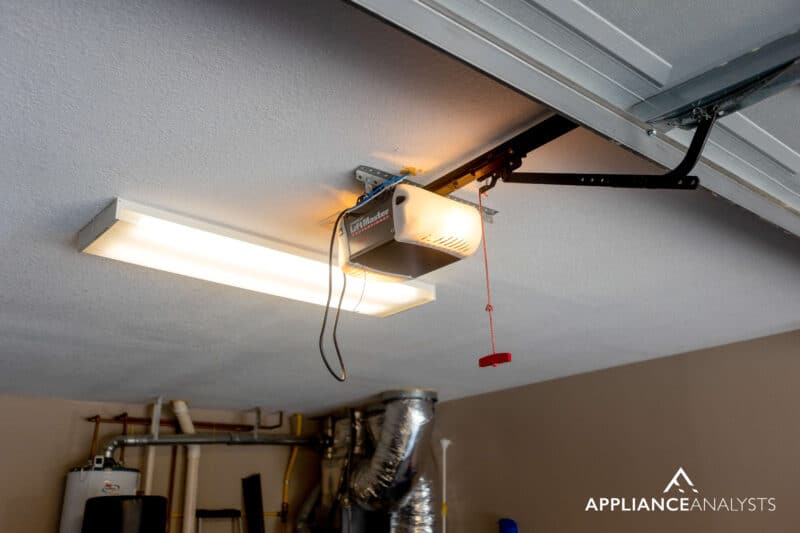
Checking the batteries
The first step if you think your garage door remote is losing range should always be to check if the batteries aren’t dead or dying. As a battery dies it puts out less power, which can affect the signal strength a remote can give out.
Most decent remote batteries should last around 3 to 5 years on average, but faulty batteries or accidental pressing of the button can cause them to die a lot sooner than that. Older batteries can also corrode or leak, which can cause damage to your remote and prevent it from working long-term, even if you change them soon after.
Remote batteries aren’t particularly expensive. You should be able to buy them in most good supermarkets and hardware stores. If you struggle to find them, the dealership that sold you your product can generally point you in the right direction or order you a set. Some even offer free replacements as part of their service.
Even if you’ve recently set up your remote garage door opener, you should still test the batteries first.
Sometimes, batteries could have sat for a significant chunk of time in a warehouse and could be low or dying before they even reach your home.
Changing the batteries is the simplest and cheapest step you can take, so always check the batteries first.
Make sure the remote is working
The reason electronics and other signals cause issues is that the receiver built into your garage door opener can’t accept more than one frequency at a time. This means if there’s something that’s emitting a similar frequency to the one your garage door opener uses, it blocks the signal and stops your remote from picking up on it.
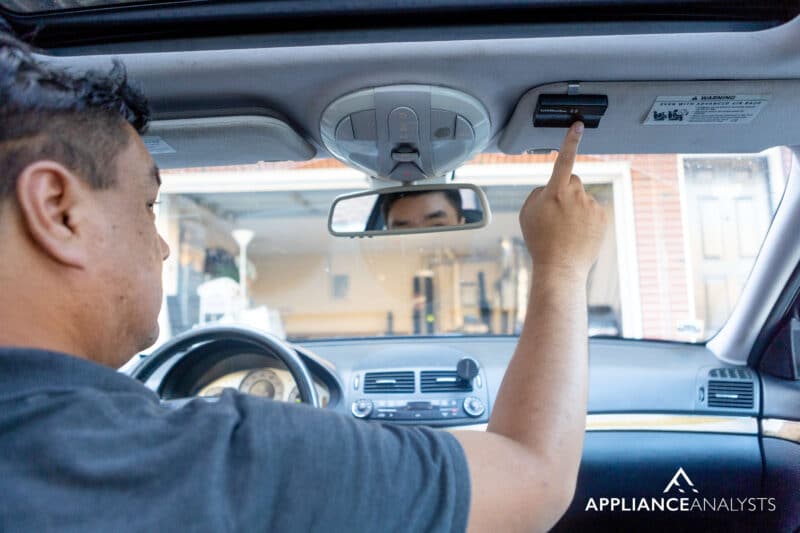
The simplest way to test this is to use the manual door opening button. If your garage door has a manual, wired button that works every time, then it’s likely that you’re experiencing signal interference.
You can also test by standing very close to the aerial of your system and using the remote. If it picks up from extremely close range but not from any real distance, it might be struggling to pick up the signal.
Testing for interference
There’s a simple way to check whether your garage door is suffering from electrical interference. It’s recommended to have someone help out to massively speed up the process.
- Find your circuit breaker box, and switch off everything except the power to your garage door opener.
- Check the range of the remote to see if it’s improved, or whether you have an intermittent signal. If your garage door opens every time, or from a longer range, you’ve just found the problem.
- Power on everything in the house one by one, retesting the remote every time. You’ll need to wait a minute or two after flicking each switch. A lot of modern tech takes a few minutes to cycle and start emitting the signals that cause the problem.
- Once you’ve found which switch is causing the issue, you can work out what’s connected to that circuit, and cycle through all of the appliances by unplugging them all, and then plugging them back in one by one.
- This process can take a little time, but it’s the simplest and surest way to work out exactly where the interference is coming from. And once you’ve worked it out, you can solve the problem.
Check the frequency
The frequency used by newer garage door openers is constantly being updated to make them more efficient and less likely to see interference. But if your door opener is reasonably old, specifically if it was made before 1993, or if you know you live in an area of high electrical interference, it might be worth investing in an upgrade.
Generally, your instruction manual will have the frequencies used in your garage door opener.
Older models will generally use 390 Mhz, which is open to heavy interference.
Newer models are significantly better. Most of them will use twin or tri-band frequencies that also use 310 and 315 MHz, meaning they’re broadcasting across multiple frequencies with various security options built in. This cuts down on the chances of interference. It also makes it much less likely that anyone can hack your door frequency and cause it to open- a plus for home security.
Fix your remote
After a few years of hard use, a remote can start to break down. There are several things that can signal wear and tear, so do some quick and easy troubleshooting:
Start by checking your remote’s indicator light. Most remote controls will have an LED that lights up when it’s active. If your indicator light is dull, flickers irregularly, or is completely dead, that’s a good sign that the remote isn’t working correctly. Check the batteries, and if that doesn’t help, the remote is probably dead.
When you’re checking the batteries, it’s also worth checking the battery contacts on your remote. Used over time, they can move apart and weaken the connection to the battery, which lowers the power running through the remote. You can try to bend them back in place, or just replace the remote itself.
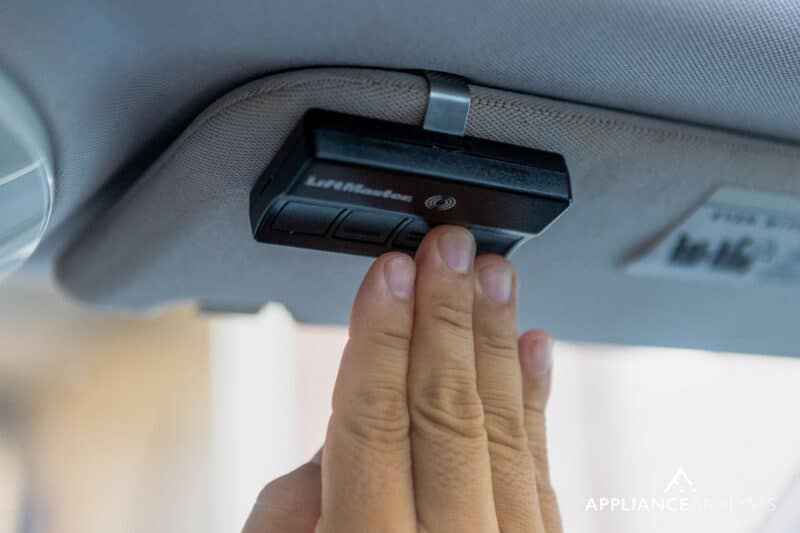
If you’re worried about the remote not working, a lot of dealerships will have a way to test the signal strength of your remote, and will also normally be able to come out to your house and test your system in situ.
Finally, you can upgrade your remote to a stronger, universal model. Brands like Liftmaster Chamberlain offer key chain remotes that can be programmed to work with almost all major brands on all frequencies and are relatively inexpensive.
Set up an antenna booster
Your automatic door opener almost certainly uses an aerial to pick up the signal from the remote, and in most models, this hangs down from the casing itself.
Most antenna are around 10 to 12 inches long and may be brightly colored for visibility. When set up, they need to be placed in a way that gives them a clear angle to the position from where you’re going to be pressing the remote so the signal is clear and uninterrupted.
One way to improve signal reception is to buy an aerial extension kit. There are lots of options on the market, designed to fit most of the major brands, and it’s a simple fix that can boost the range of your remote to upwards of a hundred feet.
Final Thoughts
- The most common problems are dying batteries and electrical interference
- Changing your remote control and upgrading your antenna can help
- If you have a very old garage door opener, upgrade the entire unit. The amount of improvements in the last twenty years has been huge
Hopefully, this article has taught you how to fix your garage door issues.
If this content helped you, please consider checking out the articles below.
Thanks for reading, and have a great day.






